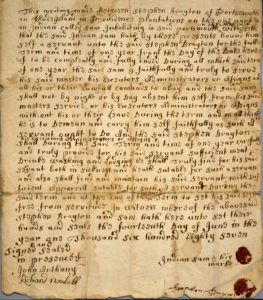
An indenture between “Stephen Brayton of Portsmouth on Rhode Island in Providence Plantations on this one part & an Indian called Sam inhabiting in said Portsmouth.”
FIC.2020.132, Newport Historical Society Collection
While it is generally accepted in our line of work, and among our audiences, that the best history is inclusive, telling our stories from a variety of perspectives, there remains a great deal of discussion about how best to do so. Especially when addressing past practice of omitting the facts of slavery and the slave trade, and Native American genocide and betrayal, when talking about American history.
We recognize the importance of including the existence of and the perspective of those whose presence has been neglected in past tellings: the poor, women, free and enslaved people of color, and the First Nations. An often-cited excuse for why these stories have not been included is that “they don’t survive in the historical record.” But, as an institution with a vast manuscript collection devoted to a single county in the nation’s smallest state, we can say emphatically that this is not true. Individual lives can be teased out of the record in a number of ways, and increasingly, historians are now doing so. This is demonstrated in the Smithsonian Magazine’s recent article on new online database called “Enslaved: Peoples of the Historic Slave Trade,” which consolidates digitized materials in order to reconstruct the lives of people involved in the historical slave trade.
Resources like the ones detailed on our Know Your History page will help historians, and the public, to “find” those individuals whose stories have been hidden and bring them to light.